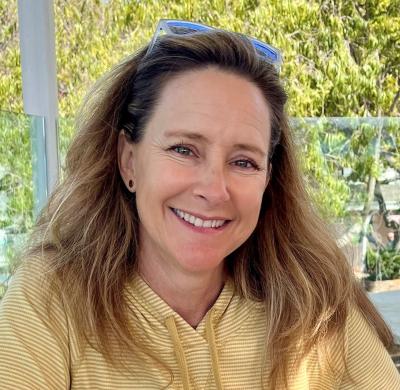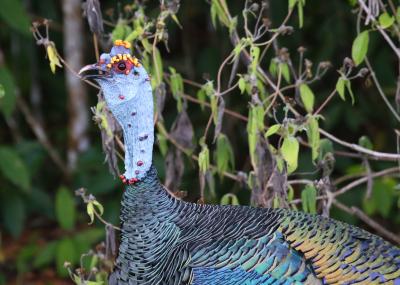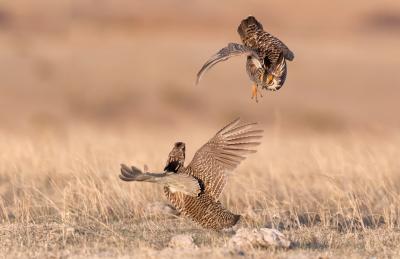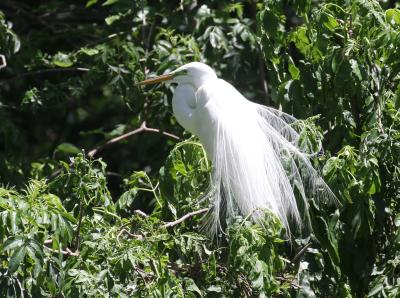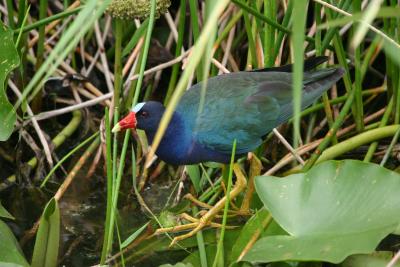North Carolina
Pelagics and Pineywoods
-
May - Jun, 2027
Skye Haas
Day 1: The trip begins at 6 p.m. with a meeting in the lobby of our Norfolk, Virginia airport-area hotel. Night in Norfolk.
Day 2: We’ll drive 2.5 hours south to North Carolina’s Alligator River National Wildlife Refuge, a rich lowland cypress swamp forest full of breeding Carolina Chickadees, Great Crested Flycatchers, Red-headed Woodpeckers, and Prothonotary, Prairie, Pine and Hooded Warblers. The refuge is home to a large number of Black Bears, and they are often observed. And of course, there are American Alligators present, along with the more approachable Eastern Box Turtle. In the afternoon, we’ll bird the barrier island habitats of Pea Island National Wildlife Refuge. Along the ocean side sand beaches and the bayside marshlands, we’ll see waterbirds like American Oystercatcher, Eastern Willet, Least Tern, Black Skimmer and Brown Pelican. Night in Hatteras.
Day 3-4: We’ll board the Stormy Petrel II on both days for our exploration of the warm waters of the Gulf Stream. We’ll look for specialty deep-water seabirds such as Black-capped Petrel, Audubon’s Shearwater and Band-rumped Storm-Petrel, along with the more widespread Atlantic species including Great and Cory’s Shearwaters, Wilson’s Storm-Petrel, Long-tailed and Pomarine Jaegers, South Polar Skua, as well as Arctic and Bridled Tern. Rare species encountered multiple times on past tours include Trindade and Fea’s Petrels, White-tailed and Red-billed Tropicbirds, and Brown and Masked Boobies. There have even been on occasion special rarities such as European Storm-Petrel and Bermuda Petrel. A pelagic trip here in late May offers the best chance one has to see these species in ABA waters. Cetaceans such as Short-finned Pilot Whale, Spotted and Bottlenose Dolphins are regularly observed, as are, on occasion, Sperm Whale, False Killer Whale and both Cuvier’s and Gervais’s Beaked Whales. Other marine life often encountered includes Loggerhead and Leatherback Sea Turtles, various shark species, Ocean Sunfish and schools of flying fish. Nights in Hatteras.
Day 5: We’ll bird our way off the barrier islands via multiple ferries, each trailed by flocks of Royal, Common and Sandwich Terns augmented by hundreds of Laughing Gulls. We’ll visit several different types of salt and freshwater marshes to look for species like Black-necked Stilt, Gull-billed Tern, King and Clapper Rails, waders such as Tricolored Heron and both Glossy and White Ibis, Seaside Sparrow and Boat-tailed Grackle. We will also keep our eyes open for Wilson’s Plover and Least Bittern. Night in Morehead City.
Day 6-7: We’ll explore the longleaf pine savannas of the Croatan National Forest, managed with controlled burns to create habitat conditions ideal for the endangered Red-cockaded Woodpecker. Brown-headed Nuthatch, Eastern Towhee, Blue Grosbeak, Great Crested Flycatcher, Eastern Wood-Pewee, Wild Turkey, Yellow-billed Cuckoo, and Brown Thrasher thrive here as well. Two local specialty species will be prime targets, Bachman’s Sparrow in the pineywoods and Swainson’s Warbler in nearby bottomland tangles. Other warbler species we’ll likely encounter include Worm-eating, Yellow-throated and the southeastern race of Black-throated Green Warbler known as “Wayne’s Warbler”. Birds such as Northern Bobwhite, Summer Tanager, Acadian Flycatcher, and Painted Bunting are all possible. Butterflies abound, ranging from the huge Giant Swallowtail to the tiny Little Metalmark, and many others. Herpetofauna we’ll likely observe include Eastern Rat Snake, Eastern and Striped Mud Turtle, and Eastern Narrowmouth Toad. Night in Morehead City.
Day 8: We’ll return to Norfolk, VA, a drive of 3.5 hours, where the tour concludes.
ENTERING THE UNITED STATES: Non-U.S. citizens will need a valid passport and may need a tourist visa or visa waiver. Consult your nearest U.S. Consulate or Embassy for details. Canadian citizens should carry proof of citizenship in the form of a passport or birth certificate. U.S. citizens should bring some form of identification such as a driver’s license.
Please note that non-US citizens are required by law to carry passports/visas with them at all times. We suggest you carry these documents with you in your day pack or some place that is easily accessible (not locked in your luggage). Given our proximity to the US-Mexico border, US Border Patrol checkpoints will be encountered on the roads and foreign nationals may be required to produce passports.
PACE OF THE TOUR: A fair mix of some walking and some birding by car, as well as being on a boat for two days. The walking is all easy to moderate. Mostly on trails or dirt roads, but there will be a couple times of walking short distances on sand beaches. The length of the walking would be 1-2 miles depending on the desires of the participants. Please consider bringing motion-sickness medication if needed, or just in case.
HEALTH: North Carolina presents no real hazards to the visiting birdwatcher.
Smoking: Smoking is prohibited in the vehicles or when the group is gathered for meals, checklists, etc. While in the field or traveling, use of a smokeless alternative such as nicotine gum is requested. Please do not smoke at short stops while traveling. If you smoke in the field, do so well away and downwind from the group and leave ample time between smoking and getting back into the vehicle. If you are sharing a room with a non-smoker, please do not smoke in the room. If any lodge, accommodation or location where the group is staying or is gathered has a more restrictive smoking policy than WINGS’ policy, the more restrictive policy will prevail. The leader reserves the right to modify this policy if the situation warrants it.
CLIMATE: The climate of North Carolina is most certainly warm in late May/early June. Daytimes highs average from the mid 70s-mid 80s (22-30C), with nighttime lows dropping to the low 60s (15C). Short-sleeves and sandals are acceptable field wear for at least some of our birding outings. However we will be on the coast a bit and it can be windy so having a long-sleeve shirt may be handy at times. Certainly it can be cooler over the ocean and a light jacket for our pelagic may be needed. Rain is always a possibility and raingear with boots or shoes to keep your feet dry will possibly be needed. Be sure and bring hats and sunblock.
ACCOMMODATIONS: We stay at standard motels throughout the tour, and at a historical inn while in Hatteras.
FOOD: Food is North American standard with most breakfasts and dinners taken at our accommodation or in in local restaurants. Lunches will be a combination of picnic lunches and local sandwich shop visits. We hope to have a few good seafood meals, as well.
Food Allergies / Restrictions: We cannot guarantee that all food allergies can be accommodated at every destination. Participants with significant food allergies or special dietary needs should bring appropriate foods with them for those times. Tour meal times are almost always approximate. Participant who needs to eat according to a fixed schedule should carry supplemental food. Please contact the WINGS office if you have any questions.
TRANSPORTATION: We will be traveling by 12 or 15 passenger window van or minivan, depending on the group size. Participants should be able to ride in any seat in tour vehicles and are expected to change seats with others daily.
2022 Narrative
In Brief: The WINGS spring tour this year to North Carolina was a resounding success! A total of 153 species were observed; certainly, the highest count I’ve ever had running this tour, replete with nearly all the expected breeders, lots of lingering migrants, and several rarities. We spent lots of time picking through the coastal salt marshes of the Outer Banks, where in addition to the expected breeding species of Willets, Oystercatchers, and several tern species, we seemed to have lucked out and shorebird migration was tardy this year, allowing for us to get several new species for the cumulative all-time tour list. Our time at sea was simply spectacular! I certainly have never had as many species of tubenose on the same day along the East Coast before. Of those, two were absolute standouts with close flybys of Fea’s Petrel and Trindade Petrel! Finally, our time in the Pineywoods was fantastic, with 9 species of warblers including several Swainson’s Warblers, as well as Yellow-throated, Prairie, Worm-eating, and Prothonotary Warblers by the barrel-full!
In Detail: We began our birding romp at Alligator River NWR, a location I often refer to as the source spot from where all the Prothonotary Warblers spring from. While obviously waxing poetic here, the constant sweet sound of the golden swamp warbler highlighted with flashes of yellow dashing everywhere here supports the premise! This is a delightful place that features a unique habitat- Pocosin, a southern take on a peat bog, with conifers and acidic conditions that seem at home in the north but having swapped out tag alder for blooming magnolias! Other breeding warblers and songbirds included several smart-looking Prairie Warblers, trilling Pine Warblers aplenty, Great-crested Flycatchers everywhere, and some gorgeous colored Blue Grosbeaks and Indigo Buntings. There are a great many woodpeckers here with standouts being the flashy Red-headed Woodpecker and the crow-sized Pileated Woodpecker. An unexpected treat were a couple pairs of diurnally active Barred Owls! Due to these swampy conditions, we were also treated to a pair of Anhingas; this species is not frequently encountered here being a little north of its classic northern range limits. We then made a beeline for the nearby coastal shores. The Outer Banks were certainly chock-full of migrating shorebirds this year, with highlights such as Piping Plovers, both “Eastern” and “Western” Willets, as well as Pectoral and White-rumped Sandpipers. Common breeding species included American Oystercatchers, Eastern Willets, and Least Terns.
Of course, the pinnacle of this tour is our time aboard the Stormy Petrel II, the boat operated by Brian Patteson and Kate Sutherland. While weather conspired to only allow for one as opposed to our typical two days offshore in the Gulf Stream, the number and variety of birds we saw surely made it feel like a week at sea! Certainly, one of my best days of an east coast pelagic with 11 species of tubenose observed, the action was nonstop, and everything gave fantastic looks. We had lots of the more typical gulf stream birds like Audubon’s, Cory’s, Scopoli’s & Shearwaters, and from within the hordes of Wilson’s Storm-Petrels we were able to get an excellent lesson in identifying Band-rumped and Leach’s Storm-Petrels. The spring-to-summer switch of Sooty Shearwaters to Great Shearwaters was well underway, with both species showing well, and a pleasant surprise was a Manx Shearwater that winged past the boat early on in the day. One expects to see the classic pteradroma petrel of the gulf stream and as hoped, Black-capped Petrels gave us amazing views. However, we were incredibly lucky to get two additional pteradromas - major rarities in the form of Trindade and Fea’s Petrel, both new species to the all-time world cumulative WINGS Tours master list!
With a gnarly storm the night before, the seas were just too rough the next day for the Stormy Petrel to head out so we spent the day bopping around the island, giving the salt marshes a more extended look than we did a couple days earlier. The mudflats had hundreds of Semipalmated Sandpipers crawling over them and we teased out a few new species for the tour such as Marbled Godwits and Red Knots. Unlike the previous day of marshland birding, Seaside Sparrows were very cooperative, providing excellent looks of this lifer for several tour participants. A pair of unexpected notables were a Red-throated Loon and a male Black Scoter recuperating on a salt marsh pond after that rough overnight storm, and another lovely treat were some great looks at a King Rail as well as a Gull-billed Tern. We lingered till dark that evening and we had several Chuck-will’s-widows and a singing Eastern Screech Owl.
However, the final act of this traveling road show isn’t half bad either. After spending half of a day in a relaxing transit involving a few ferry rides with a few birding stops along the way where we picked up a few new species like Clapper Rail, Black-necked Stilt and Marsh Wrens, we arrived in Morehead City, located near the Croatan Nat Forest, a coastal plain featuring extensive pineywoods savanna pocketed by swampy bogs. The main target here is of course the endangered Red-cockaded Woodpecker, a garrulous little woodpecker with a complex social structure. The young from previous broods stay on as helpers in raising the next cohort of young and loose colonies of this species are found where there are tall live pines with fire-cleared open savannas on the ground.
We left early the next morning to head out to the Pineywoods, the morning chorus of birds in the savanna is not to be missed! As was the case last year, we lucked out and walked right up to a couple of pairs making all kinds of hoopla and putting on a grand show. When we returned the next night to this location, we discovered an active nest with nestlings calling from inside! But Red-cockaded Woodpeckers aren’t the only exciting find here- the woods ring out with the whistled calls of Northern Bobwhites, the melancholic song of the Bachman’s Sparrow and a cacophony of Wood-Pewees, Great Crested Flycatchers, Yellow-billed Cuckoos, Summer Tanagers, and Prairie, Yellow-throated, and Worm-eating Warblers. We ventured back into the swamps one afternoon to the great looks of a Swainson’s Warbler while hearing several others lurking in the underbrush, all while encountering Brown-headed Nuthatches at nearly every stop! We made one more run to the coast to marvel at a Wilson’s Plover nursery- a pure joy watching those tiny balls of floof on toothpicks, with their trademark crab-killing bill already dispatching mini crustaceans. Also, out on the coast, we were treated to a fantastic look at an adult male Painted Bunting! And for our grand finale, an evening visit to the Pineywoods where we heard dueling Whip-poor-wills and Chuck-wills-Widows while Common Nighthawks displayed overhead!
This tour is scheduled for every other year departure. We intend to invoice earlier than our normal time frame (approximately in late December) for this tour due to the deadlines for the pelagic trips. This tour can take tentative registration after January of the tour year, yet will depend on space remaining on the pelagic trips. This tour will need at least 4 signups to consider a run. If you are registered and there are not enough signups and we must cancel this tour, you will receive a refund of your deposit per our refund policy.
Maximum group size seven with one leader.











































